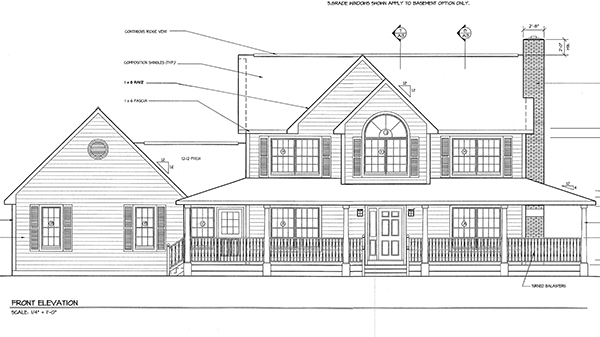Although many real estate investors choose to leave the complicated lines, measurements, and extremely fine print of blueprints to their contractors, engineers, and architects, sometimes a quick look at a property’s inner workings can tell you a lot about how a potential project might go. At times, a blueprint can even serve as a way to “turn back time” to see how a damaged property, such as one purchased in the wake of a fire, flood, or other disaster, might have looked prior to the damage.
“Both flippers and homeowners may come in with blueprints if they are looking to repair a fire-damaged home,” for example, said Doug Fritsch, director of web and package sales at 84 Lumber and a core trainer for the company. “You can match a blueprint up to new designs to identify potential problems.”
Blueprint Code Clue #1: Blueprints provide insider insight into code violations and outdated design.
For example, if a property has burned down to the foundation, an investor may have to bring that foundation up to code to pass an inspection once the repairs and remodeling are complete. “An eight-inch block foundation on an older property might have been just fine when the house was built, but now that you are doing a complete rebuild current regulations may require 12-inch foundation instead,” Fritsch observed. Because foundation modifications require additional (and sometimes costly) professional oversight, such knowledge could save you a great deal of time and money by enabling you to correctly factor in costs and time when you are evaluating a potential project.

If your blueprint shows this type of cross-section for the home, then you probably can remodel the interior as you like, including changing the layout to a more “open concept” design.
Blueprint Code Clue #2: Find out if your design dream is an option before you buy.
A blueprint can provide an investor considering altering a home’s floorplan with important information about whether the concept is workable. “Blueprints show where the weight in the house is distributed,” explained Fritsch. “In some homes, you could theoretically knock down every interior wall and the house would still stand, although I’m not recommending that! In others, there are walls, called ‘load-bearing partitions’ in the blueprint, that support the ceiling and cannot be removed. If you want to even modify them, you need to bring a structural engineer or an architect back in, adding time and money to your project.”
The issue of load-bearing walls is highly relevant to real estate investors who work on older homes, such as those built in the 1940s. In hot markets like Dallas, Texas, many fix-and-flippers focus their lead generation efforts on homes from this time period because they are often located in attractive neighborhoods and are likely to be owned by individuals who do not want to update the property before selling. This provides the investor with an opportunity to buy at a discount, update the home, and sell at a profit.
Older homes tend to have much more segmented floor plans and, furthermore, generally require complete reinstallation of modern pipes and wiring. Failure to update a floor plan can take a huge bite out of potential profits for both rentals and retail sales. Fritsch warned,
“Some walls you can blow out, and some you cannot. A blueprint will show you if the open-concept floorplan you have in mind is an option for the property you are considering.”
Blueprint Code Clue #3: Get a “crystal ball” look at the things your property needs to be competitive on the market.
Blueprints can provide guidance on what the ideal “comp” for your property will be when you renovate. If a property is located in a master-planned community, then pulling blueprints of the models available in the community will help you envision the scope of your project in advance. “Going back to our investor who has purchased a house after it burned, that investor could look at the blueprints to find out what types of upgrades and amenities were in the home before the fire to get an idea of what they will have to put in to restore or improve the value,” Fritsch said.
84 Lumber is a Think Realty supplier and offers Think Realty members a variety of discounts on their products and services. Learn more.























0 Comments